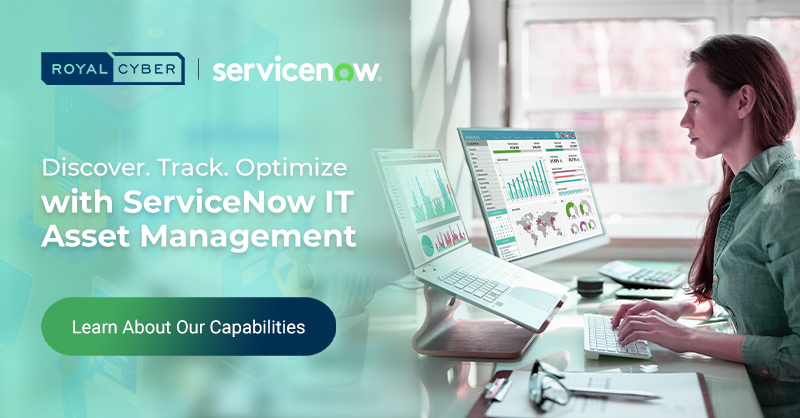ServiceNow ITAM (IT Asset Management)
Discover, Track & Optimize with ServiceNow IT Asset Management Services
What is ServiceNow ITAM?
ServiceNow IT asset management software streamlines the management of an organization’s technology assets. It facilitates the automated end-to-end lifecycle tracking of software, hardware, and cloud assets within a unified platform. It encompasses IT assets’ physical, contractual, and financial attributes, fostering informed decision-making for technology investments.
ServiceNow premier partner Royal Cyber will help you manage assets across your organization, centralize IT and non-IT assets management, and establish standardized processes to reduce manual efforts significantly.

Benefits of IT Asset Management Services
Centralized Asset Repository
Consolidate hardware, software, and cloud assets into a single platform, providing a unified view of your entire inventory.
Improved Visibility
Use AI and native intelligence on the ServiceNow IT asset management platform to gain insights into asset costs, usage, and compliance.
Asset Lifecycle Automation
Automate end-to-end processes for software, hardware, and cloud assets, optimizing costs and reducing risk.
Streamlined Procurement Process
Efficiently manage procurement workflows, from request to contract renewal, ensuring timely asset acquisition.
Efficient Incident Resolution
Quickly identify and resolve asset-related issues, minimizing downtime and improving service quality.
Compliance Management
Monitor licensing, mitigate risks, and maintain compliance with industry standards and regulations.
Integration with ITSM Processes
Integrate asset management with incident, problem, and change management for efficient operations.
Reporting and Analytics
Get informed decision-making with meaningful reports and analytics on asset utilization, costs, and performance.
ServiceNow ITAM Featured Capabilities
- SaaS License Management: Efficiently manage software-as-a-service licenses to stay compliant and control costs.
- Asset Onboarding and Offboarding: Get a high-level overview of your asset portfolio. Visualize key metrics and trends.
- Enterprise Asset Management: Streamline asset management across your organization from procurement to disposal.
- Asset Management Executive Dashboard: Seamlessly onboard and offboard assets. Simplify processes and enhance productivity.
- Contract and Renewal Management: Keep track of contracts, renewals, and compliance. Optimize vendor relationships.
Royal Cyber Offerings for IT Asset Management
ServiceNow ITAM Assessment
Empower smarter ServiceNow decisions: Get a comprehensive assessment to optimize IT assets, reduce costs, and unlock high performance.
ServiceNow ITAM Jumpstart
Need help getting started with ServiceNow? Launch our ServiceNow SPM jumpstart package for rapid deployment and immediate value.
ServiceNow IT Asset Management Resources
ServiceNow IT Asset Management (ITAM) FAQs
ServiceNow IT Asset Management (ITAM) and Configuration Management Database (CMDB) are both integral components of the ServiceNow platform, but they serve distinct purposes:
ServiceNow ITAM: IT Asset Management (ITAM) in ServiceNow focuses on managing the lifecycle of IT assets within an organization. It encompasses processes for procurement, deployment, maintenance, tracking, and retirement of IT assets such as hardware, software, and licenses. ITAM helps organizations optimize asset utilization, ensure compliance with licensing agreements, and minimize financial risks associated with asset management.
ServiceNow CMDB: The Configuration Management Database (CMDB) is a central repository within ServiceNow that stores information about all configuration items (CIs) in an organization’s IT environment. This includes hardware, software, infrastructure components, services, and their relationships. The CMDB is a foundation for various IT management processes, such as incident management, change management, and service mapping. It provides a comprehensive view of the IT landscape and facilitates accurate impact analysis during change or incident management processes. In summary, while ITAM and CMDB manage IT assets and configurations, ITAM primarily focuses on asset lifecycle management. In contrast, the CMDB is a configuration data repository essential for various IT management processes.
An IT Asset Management (ITAM) program refers to a structured approach or framework adopted by organizations to effectively manage their IT assets throughout their lifecycle. This program encompasses policies, procedures, tools, and practices aimed at optimizing the use of IT assets, minimizing costs, ensuring compliance with licensing agreements, and mitigating risks associated with asset management.
Key components of an ITAM program may include:
- Asset Discovery and Inventory: Identifying and cataloging all IT assets within the organization, including hardware, software, and associated configurations.
- Asset Procurement and Deployment: Establishing processes for acquiring new assets, managing vendor relationships, and deploying assets according to organizational needs and standards.
- Asset Tracking and Management: Implementing systems and tools to track IT assets’ usage, location, and status throughout their lifecycle.
- License Management: Monitoring software licenses, ensuring compliance with licensing agreements, and optimizing license utilization to minimize costs.
- Asset Maintenance and Retirement: Establishing procedures for maintaining assets, conducting regular audits, and retiring assets at the end of their lifecycle in a secure and compliant manner.
IT Asset Management (ITAM): ITAM focuses on the lifecycle management of IT assets within an organization. It involves processes for procurement, deployment, tracking, maintenance, and retirement of IT assets such as hardware, software, and licenses. The primary goal of ITAM is to optimize asset utilization, minimize costs, ensure compliance, and mitigate risks associated with asset management.
IT Service Management (ITSM): ITSM, on the other hand, is concerned with delivering and supporting IT services to meet the needs of the business and its users. ITSM encompasses processes, practices, and tools for designing, delivering, managing, and improving IT services throughout their lifecycle. Key ITSM processes include incident management, problem management, change management, service level management, and service desk operations. In essence, while ITAM focuses on managing physical and virtual IT assets, ITSM revolves around managing IT services’ delivery, quality, and support.
